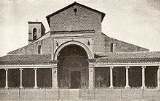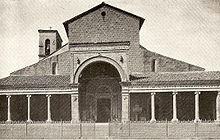
Civita Castellana
Encyclopedia
Civita Castellana is a town and comune
in the province of Viterbo
, 65 km north of Rome
.
 Mount Soracte lies about 10 km to the south-east.
Mount Soracte lies about 10 km to the south-east.
, who called it Falerii. After the Faliscan defeat against the Romans
, a new city was built by the latter, about 5 km away, and called Falerii Novi.
The abandoned city was repopulated beginning in the early Middle Ages
, with the new name of Civita Castellana (roughly translated as "City of the Castle") mentioned first in 994. In the following centuries the city was a flourishing independent commune, often contended by the Pope and the Holy Roman Empire. Captured by Pope Paschal II
at the beginning of the 12th century, the city was given as fief to the Savelli
by Gregory XIV.
Sixtus IV assigned the city to Cardinal Rodrigo Borgia, the future Pope Alexander VI
, who started the construction of the Rocca ("Castle"), which was completed under Julius II.
Civita Castellana became an important road hub with the connection to the Via Flaminia
(1606) and the construction of Ponte Clementino after the French victory against a Neapolitan army in 1709.
style, with ancient columns and mosaic
decorations. The interior was modernized in the 18th century, but has some fragments of Cosmatesque ornamentation. The high altar is made out of a Paleo-Christian sarcophagus of the 3rd or 4th century. The ancient crpyt and the old sacristy are also home to examples of central Italian medieval art.
The church of Santa Chiara has a Renaissance portal from 1529, while the Church of the Carmine has a noteworthy, small belltower from the 12th century, including antique Roman elements.
The Rocca (citadel) was erected by Alexander VI from the designs of Antonio da Sangallo the Elder
, over pre-existing fortifications, and enlarged by Julius II and Leo X
.
Ponte Clementino, the bridge by which the town is approached, dates to the 18th century.
The town also contains the ruins of the Castle of Paterno, where, on 23 January 1002, Emperor Otto III
died at the age of 22.
The National Museum of the Faliscan Countryside contains findings from the ancient Falerii and the surrounding areas.
Comune
In Italy, the comune is the basic administrative division, and may be properly approximated in casual speech by the English word township or municipality.-Importance and function:...
in the province of Viterbo
Province of Viterbo
The Province of Viterbo is a province in the Lazio region of Italy. Its capital is the city of Viterbo. It is bordered to the north by the Province of Grosseto and Siena, by the north-east with the Province of Terni and Rieti, in the west by the Tyrrhenian Sea and south by the Province of Rome.It...
, 65 km north of Rome
Rome
Rome is the capital of Italy and the country's largest and most populated city and comune, with over 2.7 million residents in . The city is located in the central-western portion of the Italian Peninsula, on the Tiber River within the Lazio region of Italy.Rome's history spans two and a half...
.

History
Civita Castellana was settled during the Iron Age by the Italic people of the FalisciFalisci
Falisci is the ancient Roman exonym for an Italic people who lived in what was then Etruria, on the Etruscan side of the Tiber River. The region is now entirely Lazio. They spoke an Italic language, Faliscan, closely akin to Latin. Originally a sovereign state, politically and socially they...
, who called it Falerii. After the Faliscan defeat against the Romans
Ancient Rome
Ancient Rome was a thriving civilization that grew on the Italian Peninsula as early as the 8th century BC. Located along the Mediterranean Sea and centered on the city of Rome, it expanded to one of the largest empires in the ancient world....
, a new city was built by the latter, about 5 km away, and called Falerii Novi.
The abandoned city was repopulated beginning in the early Middle Ages
Middle Ages
The Middle Ages is a periodization of European history from the 5th century to the 15th century. The Middle Ages follows the fall of the Western Roman Empire in 476 and precedes the Early Modern Era. It is the middle period of a three-period division of Western history: Classic, Medieval and Modern...
, with the new name of Civita Castellana (roughly translated as "City of the Castle") mentioned first in 994. In the following centuries the city was a flourishing independent commune, often contended by the Pope and the Holy Roman Empire. Captured by Pope Paschal II
Pope Paschal II
Pope Paschal II , born Ranierius, was Pope from August 13, 1099, until his death. A monk of the Cluniac order, he was created cardinal priest of the Titulus S...
at the beginning of the 12th century, the city was given as fief to the Savelli
Savelli
thumb|300px|The Coat of Arms of the Savelli over a wall of the church of [[Santa Maria in Aracoeli]], [[Rome]].The Savelli were a rich and influential Roman aristocratic family who rose to prominence in the 13th century and became extinct in the main line with Giulio Savelli .The family, who held...
by Gregory XIV.
Sixtus IV assigned the city to Cardinal Rodrigo Borgia, the future Pope Alexander VI
Pope Alexander VI
Pope Alexander VI , born Roderic Llançol i Borja was Pope from 1492 until his death on 18 August 1503. He is one of the most controversial of the Renaissance popes, and his Italianized surname—Borgia—became a byword for the debased standards of the Papacy of that era, most notoriously the Banquet...
, who started the construction of the Rocca ("Castle"), which was completed under Julius II.
Civita Castellana became an important road hub with the connection to the Via Flaminia
Via Flaminia
The Via Flaminia was an ancient Roman road leading from Rome over the Apennine Mountains to Ariminum on the coast of the Adriatic Sea, and due to the ruggedness of the mountains was the major option the Romans had for travel between Etruria, Latium and Campania and the Po Valley...
(1606) and the construction of Ponte Clementino after the French victory against a Neapolitan army in 1709.
Main sights
The cathedral of Santa Maria di Pozzano (Santa Maria Maggiore) possesses a fine portico, erected in 1210 by Laurentius Romanus, his son Jacobus and his grandson Cosmas, in the CosmatesqueCosmatesque
Cosmatesque, or Cosmati, is a style of geometric decorative inlay stonework typical of Medieval Italy, and especially of Rome and its surroundings. It was used most extensively for the decoration of church floors, but was also used to decorate church walls, pulpits, and bishop's thrones...
style, with ancient columns and mosaic
Mosaic
Mosaic is the art of creating images with an assemblage of small pieces of colored glass, stone, or other materials. It may be a technique of decorative art, an aspect of interior decoration, or of cultural and spiritual significance as in a cathedral...
decorations. The interior was modernized in the 18th century, but has some fragments of Cosmatesque ornamentation. The high altar is made out of a Paleo-Christian sarcophagus of the 3rd or 4th century. The ancient crpyt and the old sacristy are also home to examples of central Italian medieval art.
The church of Santa Chiara has a Renaissance portal from 1529, while the Church of the Carmine has a noteworthy, small belltower from the 12th century, including antique Roman elements.
The Rocca (citadel) was erected by Alexander VI from the designs of Antonio da Sangallo the Elder
Antonio da Sangallo the Elder
Antonio da Sangallo the Elder was an Italian Renaissance architect who specialized in the design of fortifications.-Biography:Antonio da Sangallo was born at Florence....
, over pre-existing fortifications, and enlarged by Julius II and Leo X
Pope Leo X
Pope Leo X , born Giovanni di Lorenzo de' Medici, was the Pope from 1513 to his death in 1521. He was the last non-priest to be elected Pope. He is known for granting indulgences for those who donated to reconstruct St. Peter's Basilica and his challenging of Martin Luther's 95 Theses...
.
Ponte Clementino, the bridge by which the town is approached, dates to the 18th century.
The town also contains the ruins of the Castle of Paterno, where, on 23 January 1002, Emperor Otto III
Otto III, Holy Roman Emperor
Otto III , a King of Germany, was the fourth ruler of the Saxon or Ottonian dynasty of the Holy Roman Empire. He was elected King in 983 on the death of his father Otto II and was crowned Holy Roman Emperor in 996.-Early reign:...
died at the age of 22.
The National Museum of the Faliscan Countryside contains findings from the ancient Falerii and the surrounding areas.
Sources and references
- Boscolo, Silvia, Luca Creti, Consuelo Mastelloni (1993) Il pavimento cosmatesco della Cattedrale di Civita Castellana. Biblioteca e società 23(1-2).http://www.bibliotecaviterbo.it/rivista/1993_1-2/Boscolo_creti_mastell.pdf http://www.newadvent.org/cathen/03798a.htm

